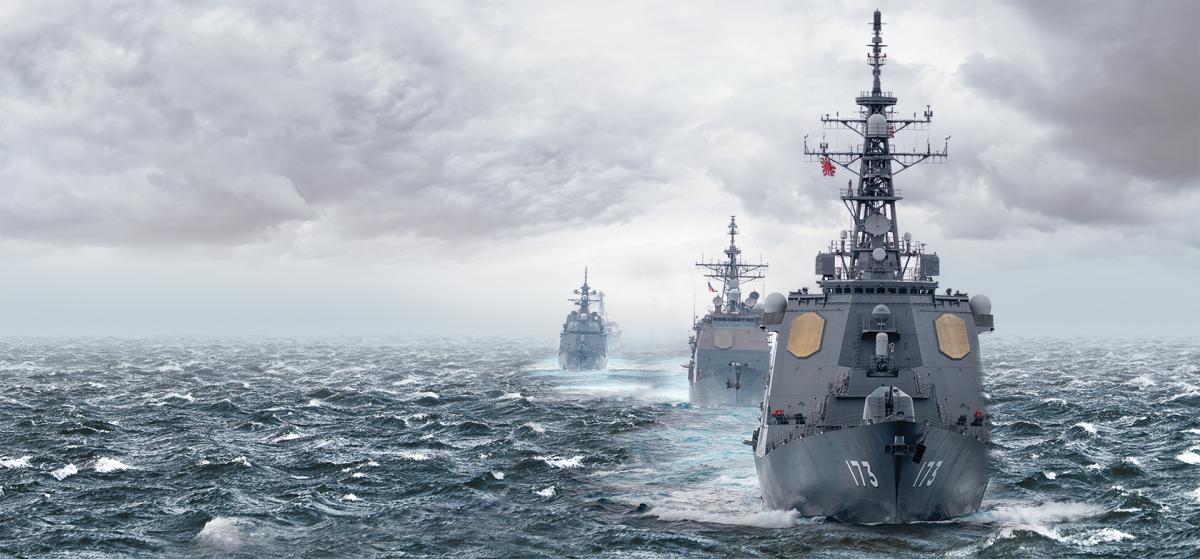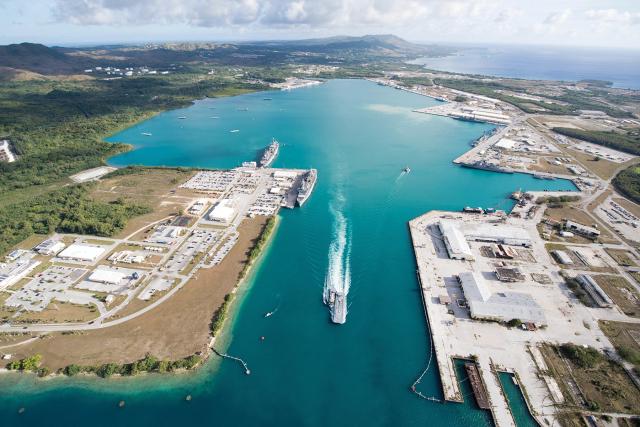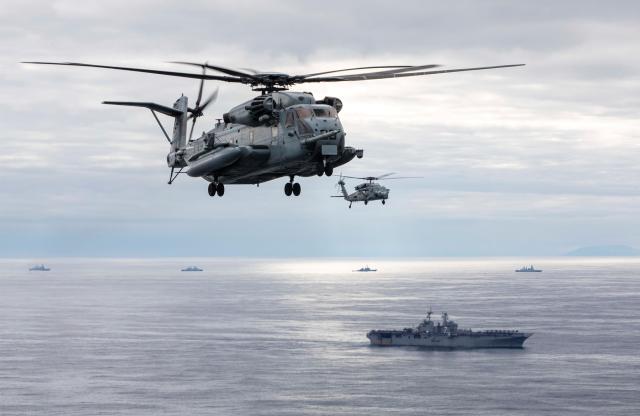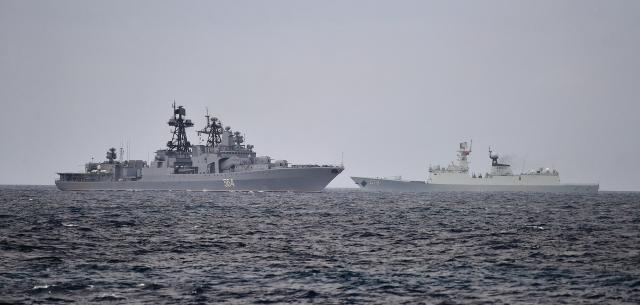
With publication of Advantage at Sea, the Navy, Marine Corps, and Coast Guard have a cogent, broad-based strategic theory of how to apply naval power in the turbulent 21st century. Advantage focuses on the growth of peer competition with China and Russia, while reemphasizing traditional broad naval objectives of power projection, sea control, strategic deterrence, and strategic sealift. Though these four pillars of naval activity go back in one form or another to Alfred Thayer Mahan, they remain a sound structure through which to view the application of maritime power at a strategic level.1
But moving from high-end global strategy to operational activity requires understanding that tactical competition and physical geography drive much of the needs of and choices available to planners—hence, the “geo” in geopolitics.2 The key theaters of competition between the United States and China and Russia are clear: the South China Sea and the North Atlantic, including much of the Arctic Ocean. There are other zones of concern (the Arabian Gulf and eastern Mediterranean, for example), but the South China Sea and North Atlantic are central to renewed great power competition. They will require a new and very specific conceptual approach if the Sea Services are to succeed in their overall mission: theater deterrence.

The most difficult region for the U.S. military to establish theater deterrence will be the South China Sea. It will require, in part, building a coalition of nations willing to help push back on Chinese claims and holding on to and enhancing the defenses of existing regional forward bases, such as Naval Base Guam. Credit: U.S. Navy (Stacy D. Laseter) / Naval Base Guam
“Theater deterrence” is not a term currently in general use, even among military planners. It subsumes part of both sea control and power projection, as well as some level of “counterforce” and “countervalue” planning from the discipline of strategic arms control. Theater deterrence, however, goes beyond simple forward presence, as it carries connotations of precisely scaled and measured military capability.
Deterrence is the art of creating the fear of attack in the mind of an opponent. Theater deterrence, then, can be defined as having sufficient combat power within a given geographic theater that the enemy would hesitate to undertake hostile operations. If you have sufficient military force available to overmatch an opponent if you get into a fight, the bad guys will be hesitant to start one.
The U.S. military looks around the world through the eyes of the combatant commanders, who are authorized to conduct combat operations, create the operational and contingency plans that drive such operations, and are the end users of this idea of theater deterrence. To understand what theater deterrence means in practical terms, let’s look at the concept in the two dangerous sea spaces mentioned, including the types and dispositions of forces to create the necessary deterrent effect on China and Russia.
In the South China Sea
The most difficult region of the world for the U.S. military to establish theater deterrence will be the South China Sea. China is deeply motivated to ensure its unfettered operations there, regarding the South China Sea as territorial waters out to the nine-dash line. The resulting body of water—roughly the size of the Gulf of Mexico and Caribbean Sea combined—is the “home court” for its military. In particular, the People’s Liberation Army Navy (PLAN) will seek to control these waters, using a combination of its own highly capable surface combatants; submarines, both nuclear attack and diesel; land-based aircraft; long-range cruise and hypersonic missiles; unmanned air, sea, and undersea vehicles; bases and logistics on the many artificial islands it has constructed; and highly capable offensive cyber operations.3
Given the extremely formidable PLAN capabilities (especially when added to overall Chinese military power), the U.S. military will be hard-pressed to maintain constant levels of theater deterrence in the region. The best approach will be for the United States to increase its maritime deployments to the region while building a coalition of nations willing to operate with it in creating theater deterrence. Thus far, Australia, Great Britain, Japan, and France have demonstrated the maritime capability and indicated a potential willingness to participate, at least at the level of joining current freedom of navigation patrols. For the United States, this is a start for building a coalition strategy that may bring those partners alongside in pushing back on Chinese claims. Other potential partners over time might include NATO broadly (this issue was discussed at the last alliance meeting of foreign ministers), Singapore, South Korea, Vietnam, and eventually Taiwan and India.
In addition to coalition building, the United States can create a higher level of theater deterrence by improving its technology. China is betting heavily on its hypersonic missiles and subsurface forces to attrite U.S. forces in a firefight within the confines of the South China Sea. It also believes cyber can play a key role, as can its artificial islands. By demonstrating technological solutions to such problems, the United States reduces Chinese confidence in achieving a successful military outcome.
This would argue for funding anti-hypersonic cruise missile systems (notably laser-based or high-power microwave solutions, since the kinematics of conventional antiair missiles systems, even Aegis based, are very challenging). It also means better cyber defenses (and offensive cyber capability) and a demonstrated contingency operation to take out the artificial islands, preventing them from becoming essentially “unsinkable aircraft carriers” for the PLAN. The United States also must hold on to its existing regional forward bases, enhancing their defenses, from Japan to South Korea to Guam.

Theater deterrence in the North Atlantic will be easier to create and maintain, as the United States has long experience in these waters. In addition, the NATO alliance is fully engaged in this “home court,” including capable warships and land-based aviation from Norway and the United Kingdom in particular. U.S. Navy (Larry Darnell Lockett Jr.) / A U.S. Marine Corps CH-53 and Navy MH-60S fly alongside ships of the Iwo Jima Amphibious Ready Group, HMS Queen Elizabeth Carrier Strike Group, and the French and Norwegian navies in the Atlantic.
Finally, the U.S. military must “up its game” in terms of tactics, techniques, and procedures that focus on creating real theater deterrence in the minds of the Chinese. A prime example is the ground-breaking approach of Marine Corps Commandant General David H. Berger. He is creating a new set of tactical capabilities and procedures that will be resident in and carried at sea by the Marine Corps (operating from Navy ships and perhaps even Coast Guard or merchant marine vessels), especially in the South China Sea.
By putting new tools and tactics in the hands of Marines at sea, General Berger hopes to wreak havoc on China behind its island chain defenses. For example, he has placed a high priority on antiship and antisubmarine operations, missions that have been far from the emphasis of the modern Marine Corps. To that end, he is looking to add significant antiship missile capabilities in the form of land-based Tomahawk missile equivalents and artillery rocket systems. This is smart thinking.
Illustrating this approach, Lieutenant General Eric Smith, the Marine Corps requirements chief, said in recent testimony, “I’m not looking to block a strait permanently. I’m looking to maneuver . . . applying the appropriate amount of pressure and force at the time and place of our choosing to get maximum effect.” All of this would help create theater deterrence in a crucial sea space. And certainly the other U.S. military services—especially the Coast Guard—could join the Navy–Marine Corps team in these efforts.
All of this represents a cultural warfighting shift away from ground wars in the Middle East and Afghanistan for the Marine Corps, and for the other Sea Services and the U.S. military broadly as well. Theater deterrence in the regions where the United States will confront China and Russia will be key; beginning with the South China Sea is vital.

The sea space from the Greenland-Iceland-UK Gap to the U.S. East Coast and up to the Arctic Circle is another area of concern, as China and Russia have drawn closer together, with their ships already operating together globally. Here, the Russian destroyer Admiral Tributs and Chinese frigate Daqing are seen prior to a joint military exercise in the Sea of Japan. Credit: Getty Images (TASS/Yuri Smityuk)
In the North Atlantic
Another zone in which theater deterrence must be created is the North Atlantic. Covering the sea space from south of the Greenland-Iceland-UK (GIUK) Gap to the U.S. East Coast and up to the Arctic Circle, this is an area of serious superpower disagreements over territory and sea lanes of communication. The region is surrounded by five NATO nations: the United States, Canada, Denmark (by virtue of Greenland), Iceland, and Norway. Sweden and Finland, two key non-NATO U.S. partners, also are physically present in the region. In opposition, of course, is Russia. Under Vladimir Putin, the Navy of the Russian Federation has become much more aggressive operationally from the Arctic Circle to the GIUK Gap and south to the waters off the U.S. mid-Atlantic coast.4
This region is particularly salient, because over the past five years, China under President Xi Jinping and Russia under President Putin have drawn closer together. Russia has a dwindling population and vast natural resources, especially oil and gas; while China has a huge population and lacks many natural resources. As China works to implement its clever geoeconomic Belt and Road Initiative, its eye is drawn inexorably to Russian resources. Russia, on the other hand, has a fairly weak economy (really a one-trick pony of hydrocarbons) and looks to China over time to be a strong geopolitical partner. Their ships are already operating together globally, including in the Baltic Sea in the heart of Europe.5
Theater deterrence in the North Atlantic will be easier to create and maintain than in the South China Sea. While Russia has a highly capable Northern Fleet (with advanced nuclear-powered submarines), the United States has long experience in these waters, and its submarine forces are still dominant. In addition, the entire NATO alliance is fully engaged in this “home court,” including capable warships and land-based aviation from Norway and the United Kingdom in particular. Russian long-range air has farther to go and will have to pass largely through NATO-controlled airspace.
The United States has responded to the resurgent Russian threat organizationally by recommissioning the historic Second Fleet, based in Norfolk, and given it responsibility for this geographic and geopolitical mission of theater deterrence. NATO has likewise re-created a version of the old Supreme Allied Commander, Atlantic, in the form of Joint Force Norfolk. Its mission, alongside Second Fleet, is at heart to establish theater deterrence in the North Atlantic up to and including the high northern regions of the Arctic Ocean. In many ways, this is a “back to the future” moment in reestablishing a seagoing NATO presence day-to-day in the face of Russian activity.
Any face-off with Russia will have a significant technological component. Like China, Russia has a highly capable offensive cyber capability, and thus U.S. operations to blunt its cyber tools defensively while deterring their employment through judicious use of offensive cyber capability will be important. Russia is leading globally in fielding ultra-long-range nuclear-powered (and nuclear-tipped) torpedoes, an especially pernicious potential threat. Hypersonic missiles are emerging as part of its suite of offensive weapons that could be directed against U.S. targets. Developing technological counters—and ensuring that NATO partners are capable of integrating fires with them—will be key to theater deterrence.
The United States also should lead an effort to explore the use of forward operating bases in Iceland and Greenland, which occupy prime geographic positions and are part of the NATO coalition. Both Sweden and Finland have island territories near the Arctic Circle. This also is an area where the new operational ideas put forward by the Marine Corps could be employed—and, of course, the Marines have a long history of interoperability with the Norwegians, as does the U.S. Coast Guard. Finally, it is worth noting that operations closer to the Arctic Circle will require technology, tactics, and procedures for coping with the harsh conditions. The United States needs to fulfill the requirements for ice-breaking capability and provide training opportunities as well. An alliance effort in this regard would make a great deal of sense.
Other Scenarios
Looking elsewhere, there are a handful of other locations where theater deterrence would make sense as part of the U.S. military approach. The first and most obvious is the Arabian Gulf. While this is not a likely location for a great power conflict, the same concept of theater deterrence is germane. The United States essentially has been conducting theater deterrence in the Gulf against Iran for the past three decades, going back to Operation Praying Mantis in 1988. Indeed, many of the concepts of theater deterrence have been honed in these difficult and confined waters.
A second area is emerging in the eastern Mediterranean Sea. Vladimir Putin’s warships have operated from the coast of the Levant to quite literally “the shores of Tripoli” as he seeks to insert Russia into events ashore in Libya, Syria, Lebanon, and Cyprus. A robust ability to operate U.S. warships in the eastern Med (perhaps leveraging bases on offer by the Greeks or even the Israelis) would be prudent. A force of two to four Arleigh Burke–class destroyers and a fairly large amphibious ship in that part of the Med makes more sense than back in Rota, Spain, a thousand miles to the west.
A New Concept is Needed
All of this requires a change in mind-set, culture, training, and patterns of deployment. Over the past two decades, the Sea Services have—appropriately—been focused on combating global terror and supporting operations in the Middle East and Afghanistan. They have stood an uneasy watch elsewhere around the globe, from the western Pacific to the Mediterranean Sea and Indian Ocean. With the reemergence of great power competition, they need a new overarching concept that inculcates part of Cold War thinking but also includes the kind of “fight tonight” mentality developed in the “forever wars.”
Theater deterrence can unsettle the minds and disrupt the plans of the Chinese and Russian great power adversaries. There are echoes of strategic deterrence and Cold War operations embedded in it, but ultimately theater deterrence practiced against other great powers is the new central concept the United States must embrace.
No comments:
Post a Comment